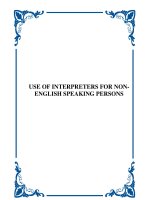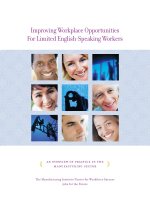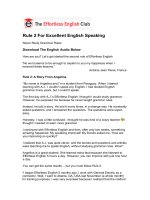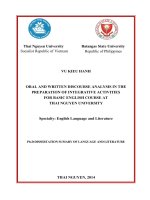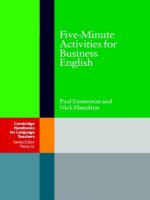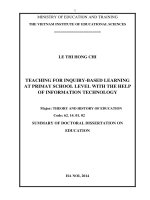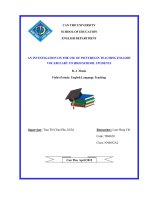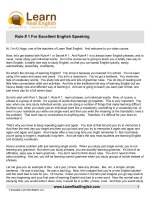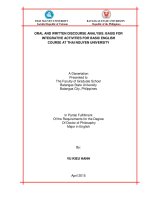Some motivational activities for students english speaking at high school
Bạn đang xem bản rút gọn của tài liệu. Xem và tải ngay bản đầy đủ của tài liệu tại đây (295.76 KB, 16 trang )
TABLE OF CONTENT
Page
1.1 Reasons for choosing this subject.........................................................................................................1
1.2 Purposes of research.............................................................................................................................2
1.3The scope of the research......................................................................................................................2
1.4 Methods of research.............................................................................................................................3
1.5 Scientific novelty...................................................................................................................................3
2.1 Justification of scientific research.........................................................................................................3
2.2 Organization and conduct of the approach to solving of problems in teaching speaking in English. 4
2.6. Results of the research.......................................................................................................................13
3.2 Some theoretical recommendations for creating motivational background....................................15
IV.BIBILIOGRAPHY......................................................................................................................................16
I.
INTRODUCTION
1.1 Reasons for choosing this subject.
I am increasingly confronted with the fact that the knowledge of a foreign
language becomes a vital necessity. I would like to note that the most popular
language now is English. Foreign language promotes the development of mental
processes.
This is due to the fact that when studying a foreign language a person has
to operate with a different system of signs. Syntactic constructions and grammar
develop abilities for analysis and synthesis, memorizing lexical units operational memory, studying not only individual words, but also the context as
a whole linguistic conjecture, intelligence and attention. The language teaches to
think logically, and also to choose the right variant from the set of values of each
individual word.
Learning a foreign language develops the speech-motor apparatus of the
child and, in addition, is a good prevention of speech defects.
Foreign language promotes the development of communicative abilities, as
well as the removal of psychological barriers. The child through learning the
language (through dialogue, skits, monologic statements) becomes more
sociable, and therefore more successful in the future [3,5].
I would like to note that learning a foreign language is not just a matter of
fashion or someone's whim, but a process of obtaining knowledge that is vitally
important in a modern society developing towards globalization.
The reason for my choice of the topic is due to the fact that there is a
contradiction between the need to acquire foreign language skills for students
and the difficulties that arise during this.
Consider speaking as a type of speech activity. Initially, speaking is based
on language as a means of communication. "Language, in turn, makes
communication possible between speakers, because it is understandable for the
one who communicates information and for the one who receives this
information" [3].
“The goal of teaching speaking in a foreign language lesson is the
formation of such speech skills that would allow the student to use them in nonspeech speech practice at the level of common everyday communication” [1,7].
The realization of this goal is connected with the formation of the
following communicative skills among students:
A) To understand and produce foreign language statements in accordance
with a specific situation of communication, a speech task and a communicative
intention;
B) to exercise their speech and non-verbal behavior, taking into account the
rules of communication and the national and cultural characteristics of the
country of the language being studied;
C) To use rational methods of mastering a foreign language, independently
to improve in it.
Because of the above reasons, I carried out my own experienced initiative
in the academic year with the theme: Some motivational activities for
students’ English speaking at high school
1.2 Purposes of research
On the basis of the proposed practical recommendations, students can be
motivated to develop their speaking skills in English on the basis of English
textbooks 11 for 11 classes.
1.3The scope of the research
The subject focuses on creation of some motivating speaking exercises for
students of the grades 11 of Truong Thi high school. However, the typical
2
research objects who I boldly applied this subject are 11 B1, 11B2, 11 B3 classes
and in some typical units.
1.4 Methods of research
Theoretical methods:
- Observation of colleagues’ lessons, investigation
- Studying and analyzing scientific literature based on pedagogical
experience of teachers and scientists of other countries;
- Summarizing, highlighting of the received information
Empirical methods:
- Statistics, comparison
- Accumulation and selection of facts
- Establishing links between them.
1.5 Scientific novelty
The scientific novelty of this study is due to the design of a series of
exercises and activities in the English language classes in order to activate their
motivational level for speaking in English. This problem was studied and
presented in the form of publications of my colleagues, but more so, on a
theoretical level. The exercises and developed activities can be applied not only
in relation to the established school program, but also as independent,
completely independent exercises for achieving the set goals. That completely
proves the scientific novelty of the presented research.
II. CONTENT
2.1 Justification of scientific research
Motivation (from Latin movere) - motivation for action; Psychophysiological process that controls human behavior, defines its direction,
organization, activity and sustainability; The ability of a person to actively meet
his needs.
External motivation (extrinsic) is a motivation that is not related to the
content of a particular activity, but is conditioned by circumstances external to
the subject.
Internal motivation - motivation, associated not with external
circumstances, but with the very content of the activity.
Positive and negative motivation. Motivation based on positive incentives
is called positive. Motivation based on negative incentives is called negative.
Example: the design "if I put order on the table, I'll get a candy" or "if I do
not indulge in, I'll get a candy" is a positive motivation. The design "if I do not
put order on the table, they will punish me" or "if I dabble, they will punish me"
is a negative motivation.
Stable and unstable motivation. Steady is considered to be motivation,
which is based on the needs of the person, since it does not require additional
reinforcement.
The ability to communicate in a foreign language also presupposes the
formation of certain qualities in students that make the process of mastering the
3
language as a means of intercultural communication the most effective. It is
about education in the student:
- Interest and positive attitude to the studied language, to the culture of the
people speaking this language;
- Understanding yourself as a person belonging to a certain linguistic and
cultural community, as well as universal consciousness;
- Understanding the importance of learning a foreign language;
- The need for self-education » [2].
Let us begin to consider the often encountered difficulties in the
assimilation of such activities as speaking in English lessons.
One of the difficulties faced by students is the assimilation of speech
structures in the native language, which prevents the formation of the speech
mechanism of the language being studied. This is due to the automatic
translation by the students of the semantic units of the second language into the
native language. And also when trying to construct a speech utterance in
English, the mechanisms of speech are replaced or completely superseded.
Another difficulty that some students face with regard to speaking in a
second language are the so-called personal psychological barriers, manifested in
the uncertainty that they will be able to build monologic utterances in the
language in question, in fear that the reservations made will entail negative
Evaluation.
The most common problem is motivation. Students lack the living motives
for mastering English. As long as the student did not come to school, he solved
all his communication needs using his native language, which, in turn, was
formed under the influence of the environment, having mastered sufficiently his
native language, the student simply does not need to learn a second foreign
language [5,6,1].
Consequently, the solution to the difficulties associated with is seen in the
need to expand the circle of communication between students, the exchange of
information with their peers from other countries, which will make learning
English real and relevant. To weaken the influence of the native language
mechanism in the process of mastering the English language, it is important to
determine the content of linguistic phenomena that must be compared with each
other because of their sharp difference, and also describe the cases of
rapprochement of the native and English language mechanisms that help to
master the second language. In addition, "it is necessary to strengthen the role of
incentive assessments in the process of teaching English, noting the positive
aspects in the speech skills and abilities of the student and, on such a
background, to comment, indicate ways to eliminate gaps" [2,4].
2.2 Organization and conduct of the approach to solving of problems in
teaching speaking in English.
Before asserting the correctness of my assumption about the importance of
motivation to learning speaking in English, I and my colleagues decided to test it
4
in practice. Teachers and a foreign teacher of our school organized an
experiment, the results of which would help us establish a level of motivation to
study speaking in English. The students of the 3 eleventh grades were offered a
questionnaire developed by our teachers during the school year, based on both
theoretical and methodological literature, and on the basis of personal
experience of each of us.
NAME:
CLASS:
DATE:
TEACHER:
PLEASE READ THE FOLLOWING STATEMENTS AND
CIRCLE THE CORRECT ANSWER
1). When there is a choice between two options for doing a
homework in English, it is better to do it faster than to postpone
YES / NO
for a certain time.
2). I get easily annoyed when I notice that I can not 100%
YES / NO
complete my homework in English.
3). When there is a problematic situation during speaking in
English, I most often raise my hand one of the last.
YES / NO
4). When I have 4 days in a row there is no practice in English, I
lose my peace.
5). When I give up speaking practice in English, then I severely
condemn myself, because I know that in it I would have achieved YES / NO
success.
6). I'm more attracted to other subjects than English.
YES / NO
7). The censure of the teacher in the lesson of English stimulates
YES / NO
me more than praise.
8). I know that my classmates consider me to be able to speak
YES / NO
English as a student.
9). My mistakes in English make my decisions more solid.
YES / NO
10). When answering a question in English, I do not listen to
YES / NO
classmates' tips.
11). Sometimes I postpone what I had to do now.
YES / NO
12). The ability to speak in English is the key to my successful
YES / NO
future.
13). Whenever I have to do an important job in English, I do not
YES / NO
think of anything else.
14). During the holidays, I usually listen to British or American
YES / NO
channels.
15). My successes in English to some extent depend on my
YES / NO
classmates.
This questionnaire contained the following yes/no statements:
5
The applied experiment showed the next results:
So, based on the results of the survey, we concluded that the need in
increasing the level of motivation among students of the 3 eleventh grades:
11B1, 11B2 and11B3 at Truong Thi high school is obvious.
The department of teachers in English, in particular with a foreign teacher,
developed a series of activities according to the syllabus that, in our opinion,
could be interesting and motivating for students.
2.3. Designing independent motivational activities according to the
syllabus in 3 selected units (English textbook 11)
2.3.1. Some motivational activities:
- Short speeches: Students may be given some easy topics and they prepare
them in verbal or written form.
- Gap activity: This is a form of a dialague. One student has some
information which the other person does not have such as: an interview, self
introduction. This activity will remove the students hesitation.
- Role play: A teacher asks students to play different roles in the form of a
drama. This exercise will encourage the students to speak in real life situation.
- Discussions: A teacher will give some topics or pictures and give them
instructions how to proceed. Students will discuss the topic then the teacher or a
leader of group ask questions and discussions are carried out.
UNIT
TOPIC
Motivational activities
1). Unit 1
Friendship
Role play
6
2). Unit 3
A party
Discussion – Short speeches
3). Unit 10
Nature in danger
Gap activity
2.3.2: Research content
Here I would like to present some of the motivational activities, which
are used in three selected units in English textbook 11.
Unit 1: Friendship
Period 3- Part B: Speaking-Class: 11B1, 11B2 and 11B3.
I. OBJECTIVES: By the end of the lesson, Ss will be able to:
- Improve the speech skills of monologic speech, the development of
speech skills based on the creative use of previously learned material.
- Compare and collate Developing - the development of the ability to
compare and collate speech units, the development of the ability to carry out
reproductive and productive speech actions,
- Understand the value of friendship, see the positive qualities of the
individual and be able to talk about a friend, the formation of the need for
friendly relationships among adolescents.
II. TEACHING AIDS pictures, handout , worksheet.
II. PROCEDURE
Teacher’s activities
I. Warming-up
(5 minutes)
-Asks ss to write some statements about friends and friendship such as:
Student 1: It takes a long time to grow an old friend.
Student 2: A friend in need is a friend indeed.
Student 3: A faithful friend is better than gold
Leads Ss into the content of the lesson.
II. Pre-speaking and while-speaking
(25 minutes)
Task 1: Talk about a friend whom you like best.
-Asks ss to answer the questions:
1. What is his / her name?
2. How old is (s)he?
3. What does (s)he look like? -> good-looking, slim…
4. What are his/ her personalities? -> Hard-working, modest, generous…
5. What are his/ her hobbies? -> reading, traveling…
6. Why is he/ she interested in Maths/ English?
7. How much time does he/ she spend on English every day? -> 2-3 hours…
8. Why do you like him/ her? -> friendly, helpful …
9. What made him/ her successful? -> patient, studious …
10. What does he / she do in his/ her free time?
Match the questions with the correct answers and then practice dialogue in pairs.
Journalist
Interviewee
Task 2:
Answer
1. What’s his name?
a. He’s friendly, and helpful.
7
2. When was he born?
3. What does he look
like?
4. What are his hobbies?
5.
What
are
his
personalities?
6. Why is he interested
in Maths?
7. How much time does
he spend on Maths every
day?
8. What makes him a
good friend?
9. What is the main
reason for his success?
10. What does he do in
his free time?
b. Well, he’s thin and tall. With a bright
face, a broad forehead and thick glasses,
he looks very intelligent.
c. Reading books and playing
badminton are his hobbies.
d. He likes playing soccer. He says that
this sport can help him reduce stress.
e. I think that is precisely because he is
studious, patient and eager to learn
anything related to Maths.
f. His name is Nam.
g. He often tells me that he can see lots
a magic thing in this subject.
h. He was born in 1990.
i. He spends 2 hours a day.
studying Maths.
k. What I like most about him is that he
is very humorous.
key:
1-f
2-h
3-b
4-c
5-a
6-g
7-i
8-k
9-e
10-d
III. Post- speaking
(15 minutes)
Task 3: Role – play: Talk about a famous friend.
Model Conversation:
J: Hello, I’m… I’m a journalist for Truong Thi high school. I know you are …
friend. Could you give me some information about ..?
J: What’s your friend’s name?
I: He is Dung
J: When was he born?
I: He was born in 1990
J: What does he look like?
I: He’s tall. He has a square face with a broad forehead. He’s good-looking
J: What are his hobbies?
I: He likes doing Maths.
J: Is he friendly?
I: Yes. He’s caring , helpful to everybody
J: Thanks for giving me time. Bye.
I: You’re welcome
Unit 3: A party
Period: 14- Part B. Speaking-class: 11B1, 11B2, 11B3
I. OBJECTIVES: By the end of the lesson, Ss will be able to:
- know other parties in Viet nam and oversea countries
- describe a party and how to plan a party.
II. TEACHING AIDS: pictures, extra board, cards.
8
III. PROCEDURE
Teacher’s activities
1. Warm –up (5 minutes)
Asks ss to tell the name of some popular parties in Viet Nam e.g.:
Student 1: a Birthday party
Student 2: a Wedding party
Student 3: a New Year party
- Leads Ss into the content of the lesson.
2. Pre-speaking (20 minutes)
Task 1: Provides ss other kinds of parties.
- Show on the slide
Barbecue party- it is a party when your friends or relatives gather together in a
garden or in a forest. - Barbecue, a party in the fresh air.
Fancy dress party (word semantification with a picture on the slide) - costume
party.
House-warming party - it's a party that you have to move in.
Sit-down meal - it's means that you sit at the table with your friends or relatives.
- Asks ss to listen and repeat
- Asks ss to give translation
Task 2: Food and drink
- Opens a new slide with the names of drinks and snacks
Hot drinks - alcohol drinks. - Alcoholic beverages
Snacks - They are sandwiches, crisps and so on.
Soft drinks - juice, mineral water and so on.
- Asks ss to give translation
Task 3: Clothes
- Clothes are important, especially at the parties
Dress casually- it means that you dress. - Dressing comfortably
Dress smartly - it means that you dress tidy, clean and fashionable.- Dress
beautifully and fashionably. Wear formal clothes - Wear official clothes (the
student translates the word, as it is familiar to them)
- Asks ss to listen and repeat these words.
- Asks ss to translate
Task 4: Filling the missing words
- Asks ss to use the above words to fill it in meaning.
1. We often have a……… in the summer.
2. I hate………. Because we only eat and talk.
3. It is very harmful for your health if you drink ……….a lot.
4. There are different ………in a café.
5. I like wear ……..It is comfortable
6. If you go to a wedding you must wear……..clothes.
Answer:
1 - a barbecue party, 2- sit-down meal, 3 - hot drinks, 4- snacks, 5 - casually, 69
formally.
3. Post- speaking (20 minutes)
Task 5: Describe a party
- Divide into groups of 3 or 4 students
- Each group gets cards with the key words
- Asks ss to try to use them in their description.
Model descriptions
Group 1: We've chosen a barbecue party. We can see a large family: a
grandfather, a grandmother, a mother, a father and their children. They are
having a barbecue party. They enjoy the beautiful country side. The father is a
barbecue and the mother is telling him a joke. The grandfather and the
grandmother are chatting and enjoying the meal. The children are eating
delicious snacks and drinking soft drinks.
Group 2: We 've chosen a finishing school year party. Teens are very glad and
happy, because it is the end of the school year. They are at the party. It is a youth
party, that's why they are wearing casually: T-shirts and jeans. Of course, they
are listening to music and dancing. We think they are listening rap or R'n'B.
Students are going to have summer holidays, that's why they are laughing and
telling jokes. Some students are chatting, one of them taking photos of his
friends.
Asks ss to prepare an oral report on the last party, which was attend by students,
consisting of 10-13 sentences
10
Unit 10: Nature in danger
PERIOD 63 - Part B - SPEAKING - Class 11B1, 11B2, 11B3
OBJECTIVES By the end of the lesson, Ss will be able to:
- talk about endangered nature.
- express their own ideas about measures for protecting endangered
nature.
II. LANGUAGE FOCUS
New words words related to the nature.
III. TEACHING AIDS
pictures, handout , worksheet, real objects
IV. PROCEDURE
1. Warm up (5 minutes.)
- Asks ss to look at the apple:
Imagine it’s our Earth. I’m cutting it into 4 pieces. Three quarters of the Earth
surface is water and only 1/4 is land. One half of it is habitable. The rest of the
land is the deserts, mountains, frozen ice-caps and other places where people
cannot live in. And now I’m cutting this half into four parts. It’s impossible to
believe but only 1/32 gives us food and home. And it will be a catastrophe if we
destroy it. I’d like you to think over this problem much more seriously and find
out the ways to save our fragile planet.
- Let's begin our lesson from the revision of lexical material.
2. Pre-Speaking (20 minutes)
Task 1: Lexical charging
A/ Translate expressions from English into Vietnamese:
- Protect the environment: bảo vệ môi trường
- To solve ecological problems:giải quyết những vấn đề về hệ sinh thái
- To throw out tons of harmful substances: ném hang tấn rác thải có hại
- Industrial and nuclear wastes: rác thải hạt nhân và công nghiệp
- Poison the seas and rivers: làm ô nhiễm các dòng sông và bải biển
B/ Check vocabulary understanding by finding the definitions of some new
words in this table.
1. Ecology
a) A gas in the atmosphere. The gas that we breathe out.
11
b) The Earth is becoming warmer because there is too
much carbon dioxide in the atmosphere.
3. Flora
c) The study of how living things interact with each other.
d) When the land, sea or air becomes dirty or
4. Fauna
poisonous.
5. Habitat
e) The animals of a region
f) A place that provides animals and plants with food,
6. Pollution
water and shelter.
7. Carbon dioxide
g) It means simply what is around us.
8. Greenhouse Effect h) All the plants that grow in a region.
Answer: 1-c; 2-h; 3-i; 4-j; 5-f; 6-d; 7-a; 8-b.
2. Environment
3.While-Speaking (10 minites)
Task 2-Asks ss to look at some pictures and filling the missing words in the
following sentences:
1. …………… forests.
2. ……………………. trees for wood.
3. Discharging…………………. into the environment.
4. Killing ………………….. for fur, skin and food.
12
5. Using fertilizers and……………….for cultivation.
6. ……………… or capturing animals for recreation
7. Keeping animals as………………
Key:
1- Cutting down; 2- Burning; 3- chemicals pollutants; 4- endangered animals;
5- pesticides; 6- hunting; 7-pets.
4. Post-Speaking ?(10 minites)
Task 3: Match the reasons with possible measures for protecting the
environment below:
Reasons why nature is
Measures for protecting
threatened
endangered nature
1. Killing endangered a. Killing endangered animals for fur, skin and
animals for fur, skin and food should be banned.
food
b.Planting trees should be encouraged.
2. Keeping animal as pets c. Keeping animals as pet should be discouraged.
3. Hunting or capturing d. Zoos and national parks should be established
animal for recreation or to save animals and plants.
entertainment
e. Animals should not be capture for recreation
4. Burning forests.
and entertainment.
5. Cutting down trees for f. All kinds of animals and plants should be
wood
protected.
6. Using fertilizer and g. Discharging chemical pollutants into the
pesticides for cultivation environment should be prohibited.
7. Discharging chemical h. Decreasing the use of fertilizers and pesticides
pollutants
into
the for farming should be encouraged.
environment
Key:
1-a; 2-c
3-d,e
4-b
5-b
6-h
7-g
2.6. Results of the research
After applying activities mentioned above, we have tested the level of
motivation to speaking in English in the same grades in order to see the changes.
We noticed that the interest of students in the English language grew
significantly. Many of them were interested in additional activities. Also among
the motivated students were the least successful students throughout the training
course. Students became more active and motivated. They openly showed a
positive attitude to English classes and began to do homework with pleasure.
The results of our research showed:
13
III. Conclusion and recommendations
3.1. Conclusion
As a rule, the student's learning activity is motivated not by one motive, but
by a whole system of diverse motives that intertwine, complement each other,
are in a certain relationship among themselves.
Motivational sphere is the core. At the beginning of his school life, having
an internal position of a student, he wants to learn, and to study well, perfectly.
Among the various social motives of the teaching, perhaps the motives are "to
bring joy to the parents", "I want to know more", "I'm interested in the lesson".
With knowledge, the student receives high marks, which, in turn, are the source
of other rewards, a pledge of his emotional well-being, a matter of pride. When a
student successfully studies, he is praised by both the teacher and parents; he is
set as an example to other children. Moreover, in a class where the teacher's
opinion is not only decisive, but the only authoritative opinion with which
everyone is considered, these aspects come to the fore. And although to some
extent the concept of "good work" or the distant prospect of getting an education
in a university can not be directly motivated to a student of an elementary
school, nevertheless, social motives are important for the student's personal
14
development, and for children who do well with 1 class, they are fully
represented in their motivational schemes.
In conclusion, I would like to note that the art of education nevertheless consists
in creating the right combination of "understandable" motives and motives of "really
acting" and at the same time in the ability to timely assign a higher value to the
successful result of the activity in order to ensure this transition to a higher type of
internal motives, governing the life of the individual.
3.2 Some theoretical recommendations for creating motivational
background
For the formation of motivation, it is necessary to create favorable and
normal conditions for the course of the educational process:
- To create or restore the students a general positive attitude to stay in
school, a particular classroom,
- To improve material maintenance of educational process with equipment
(visual aids, technical means),
- To provide the necessary minimum of a stock of knowledge on the given
subject, to equip students with basic practical skills and skills of educational work.
- To form the ways of interaction and cooperation with other people;
- To educate social attitudes and ideals;
- To change the position of students in the classroom, the group (the
conversion of the student into an asset);
- To change a social role (the successful student begins to be responsible
for the unsuccessful one);
- To change the role of the evaluator and the evaluated, the ability to
assess oneself from the position of another person;
- To link the life of a classroom with the life of the school, the country.
These general conditions will create only a background for purposeful
work on the formation of motivation for learning. At the same time, without
them it is impossible to set the task of educating a full-fledged motivation. One
can not think that there are means of forming motivation, isolated from the
whole state of the educational process.
I would like to hear the comments of all my colleagues to make my
research more complete!
I hereby declare that this initiative is written due to the personal
experience, and was not copied. I respectfully thank you!
COMMENTS AND ASSESSMENT
OF THE SCIENCE COUNCIL
Thanh Hoa, May 29th, 2017
The author
Trần Thị Giang
15
IV.BIBILIOGRAPHY
1. Nguyen Hanh Dung (2003), Methods of teaching English in secondary
schools, Educational Pulisher
2. Dornyei, Z.(2002), Motivational strategies in the language classroom,
Cambridge University Press
3. Jermy Harmer, How to teach English, Saigon Cultural Pulisher.
4. Garder, R.C, and Lambert, W.E. (1972), Attitude and moyivation in
Second Language Learning, Rowley, MA: Newbury House.
5. Ratanawalle Wimolmas, Thammasat University, Thailand
6. Chu Quang Binh(2009), Design lectures in English 11, Ha noi Pulisher
7. />8. />
16
